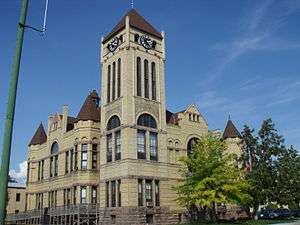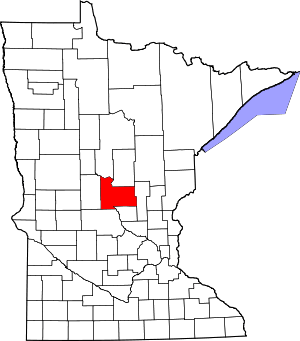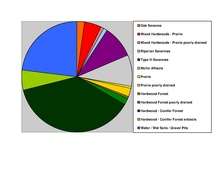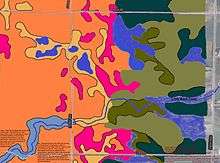Morrison County, Minnesota
Morrison County is a county in the East Central part of the U.S. state of Minnesota. As of the 2010 United States Census, the population was 33,198.[1] Its county seat is Little Falls.[2]
Morrison County | |
|---|---|
 | |
 Location within the U.S. state of Minnesota | |
 Minnesota's location within the U.S. | |
| Coordinates: 45°58′00″N 94°22′00″W | |
| Country | |
| State | |
| Founded | February 25, 1856 |
| Named for | William and Allan Morrison |
| Seat | Little Falls |
| Largest city | Little Falls |
| Area | |
| • Total | 1,153 sq mi (2,990 km2) |
| • Land | 1,125 sq mi (2,910 km2) |
| • Water | 28 sq mi (70 km2) 2.5%% |
| Population (2010) | |
| • Total | 33,198 |
| • Estimate (2019) | 33,386 |
| • Density | 29.5/sq mi (11.4/km2) |
| Time zone | UTC−6 (Central) |
| • Summer (DST) | UTC−5 (CDT) |
| Congressional district | 8th |
| Website | www |
Camp Ripley Military Reservation occupies a significant area in north-central Morrison County.
History
Dakotah and Ojibwe Indians lived in central Minnesota around the Mississippi River. French and English fur traders and voyageurs traveled through Minnesota from the 17th century to the 19th century. They used the river to transport their goods and trade with the natives. The county was named for fur trading brothers William and Allan Morrison.
In the 19th century three prominent explorers led expeditions along the river through the area that became Morrison County. Zebulon Pike came through in 1805. Michigan Territory Governor Lewis Cass led an expedition through the area in 1820. Explorer and scientist Joseph Nicollet created the first accurate map of the area along the river in 1836.
Missionaries were some of the area's first European settlers. Methodist missionaries settled temporarily along the Little Elk River in 1838. The Reverend Frederic and Elisabeth (Taylor) Ayer moved to the Belle Prairie area in 1849. They started a mission and school there for the Ojibwe. Father Francis Xavier Pierz came to the area in 1852 and started many communities in central Minnesota, including Sobieski and Rich Prairie (later renamed Pierz) in Morrison County.
The US legislature established the Wisconsin Territory effective July 3, 1836. It existed until its eastern portion was granted statehood (as Wisconsin) in 1848. The federal government set up the Minnesota Territory effective 3 March 1849. The newly organized territorial legislature created nine counties across the territory in October of that year. On 25 February 1856, Benton, one of those original counties, had a portion of its northern section partitioned off to create Morrison County, with Little Falls as the county seat.[3] It was named for William and Allen Morrison, early fur trappers and traders in the area.[4]
The event that prodded further development of the county was the building of Fort Ripley (originally named Ft. Gaines). In order to construct this military outpost, the Little Falls Mill and Land Company built a dam and sawmill in 1849. The company was formed by James Green, Allan Morrison, Henry Rice, John Irvine, John Blair Smith Todd, and Napoleon Jackson Tecumseh Dana. Fort Ripley was ostensibly built to protect the Winnebago Indians, who had been relocated by Henry Rice from Iowa to central Minnesota west of the Mississippi River, between the Crow Wing and Long Prairie rivers. Rice hoped the Winnebago would act as a buffer between the warring Ojibwe and Dakotah. His plan was unsuccessful and in 1855 the Winnebago were moved to the Blue Earth River in southern Minnesota.
The Little Falls area was first settled in 1848, and platted in 1855. Its growth occurred when the Little Falls Company (later called the Little Falls Manufacturing Company) built a second dam. This dam washed out, as had the first, and Little Falls entered a long period of economic depression and stagnant population. Bit by bit, Little Falls grew, until it was officially incorporated as a village in 1879.


Another wave of immigration occurred between 1880 and 1920. A wide variety of ethnic groups[6] settled in Morrison County. This wave of immigration was spurred by the construction of the third dam at Little Falls in 1887. A group of investors from Louisville, Kentucky led by M. M. Williams financed the dam. To be sure their investment would succeed, they encouraged other major industries to move to the city, touting the water power.
Pine Tree Lumber Company, run by Charles A. Weyerhaeuser and Richard "Drew" Musser,[7] was one business that took advantage of the water power, with their operations in Little Falls beginning in 1890. Hennepin Paper Company also started operations that year in the city.
In 1889 the Louisville investors drew up a charter to transform Little Falls from a village to a city. Nathan Richardson, one of Morrison County's original organizers, became the city's first mayor.[8]
Geography
The Mississippi River flows south through west-central Morrison County. The Platte River flows south-southwest through the central part of the county, discharging into the Mississippi just at both rivers exit Morrison County at the border with Stearns County. The Little Elk River rises in Morrison County and flows east to discharge into the Mississippi just north of Little Falls, picking up the flow of the South Branch of the Little Elk River at Randall. The Mississippi also receives the flow of the Nokasippi River just above Camp Ripley. The Skunk River rises in the northeast part of the county, and flows west-southwest through the lower central part of the county, discharging into the Platte southeast of Little Falls.
The terrain consists of low rolling hills, partly wooded, carved with drainages and gullies, and with all available area devoted to agriculture.[9] It generally slopes to the south, and slopes to the river valley from both east and west borders,[10] with its highest point on the Camp Ripley Military Reservation, 2.4 miles (3.9 km) east and 1.4 mile (2.2 km) north of the east end of Lake Alexander, at 1,521' (463m) ASL.[11] The county has an area of 1,153 square miles (2,990 km2), of which 1,125 square miles (2,910 km2) is land and 28 square miles (73 km2) (2.5%) is water.[12]
Major highways
Airports
- Little Falls/Morrison County Airport (LXL) - SE of Little Falls
Adjacent counties
- Cass County - north
- Crow Wing County - northeast
- Mille Lacs County - east
- Benton County - southeast
- Stearns County - south
- Todd County - west
Protected areas[9][10]
- Belle Prairie County Park
- Charles A. Lindbergh State Park
- Coon Lake State Wildlife Management Area
- Crane Meadows National Wildlife Refuge
- Crane Meadows State Wildlife Management Area
- Crow Wing State Park (part)
- Culdrum State Wildlife Management Area
- Ereaua State Wildlife Management Area
- Lake Alexander Woods Scientific and Natural Area
- Little Elk State Wildlife Management Area
- Mud Lake State Wildlife Management Area
- Neitermeier State Wildlife Management Area
- Popple Lake State Wildlife Management Area
- Rice-Skunk Lake State Wildlife Management Area
- Richardson State Wildlife Management Area
- Ripley Esker Scientific and Natural Area
- Sponsa State Wildlife Management Area
- Wittiker State Wildlife Management Area
Demographics
| Historical population | |||
|---|---|---|---|
| Census | Pop. | %± | |
| 1860 | 618 | — | |
| 1870 | 1,681 | 172.0% | |
| 1880 | 5,875 | 249.5% | |
| 1890 | 13,325 | 126.8% | |
| 1900 | 22,891 | 71.8% | |
| 1910 | 24,053 | 5.1% | |
| 1920 | 25,841 | 7.4% | |
| 1930 | 25,442 | −1.5% | |
| 1940 | 27,473 | 8.0% | |
| 1950 | 25,832 | −6.0% | |
| 1960 | 26,641 | 3.1% | |
| 1970 | 26,949 | 1.2% | |
| 1980 | 29,311 | 8.8% | |
| 1990 | 29,604 | 1.0% | |
| 2000 | 31,712 | 7.1% | |
| 2010 | 33,198 | 4.7% | |
| Est. 2019 | 33,386 | [13] | 0.6% |
| US Decennial Census[14] 1790-1960[15] 1900-1990[16] 1990-2000[17] 2010-2019[1] | |||
2000 census
As of the 2000 United States Census, there were 31,712 people, 11,816 households, and 8,460 families in the county. The population density was 28.2/sqmi (10.9/km²). There were 13,870 housing units at an average density of 12.3/sqmi (4.76/km²). The racial makeup of the county was 98.48% White, 0.21% Black or African American, 0.32% Native American, 0.25% Asian, 0.03% Pacific Islander, 0.15% from other races, and 0.55% from two or more races. 0.64% of the population were Hispanic or Latino of any race. 45.4% were of German, 18.8% Polish, 7.3% Norwegian and 5.7% Swedish ancestry. 96.7% spoke English, 1.4% Spanish and 1.2% German as their first language.
There were 11,816 households out of which 34.50% had children under the age of 18 living with them, 59.40% were married couples living together, 7.80% had a female householder with no husband present, and 28.40% were non-families. 24.90% of all households were made up of individuals and 11.80% had someone living alone who was 65 years of age or older. The average household size was 2.64 and the average family size was 3.15.
The county population contained 28.00% under the age of 18, 8.00% from 18 to 24, 26.70% from 25 to 44, 21.70% from 45 to 64, and 15.60% who were 65 years of age or older. The median age was 37 years. For every 100 females there were 101.20 males. For every 100 females age 18 and over, there were 99.50 males.
The median income for a household in the county was $37,047, and the median income for a family was $44,175. Males had a median income of $31,037 versus $22,244 for females. The per capita income for the county was $16,566. About 7.50% of families and 11.10% of the population were below the poverty line, including 11.40% of those under age 18 and 18.50% of those age 65 or over.
Communities
Cities
Unincorporated communities
Townships
- Agram Township
- Belle Prairie Township
- Bellevue Township
- Buckman Township
- Buh Township
- Culdrum Township
- Cushing Township
- Darling Township
- Elmdale Township
- Granite Township
- Green Prairie Township
- Hillman Township
- Lakin Township
- Leigh Township
- Little Falls Township
- Morrill Township
- Motley Township
- Mount Morris Township
- Parker Township
- Pierz Township
- Pike Creek Township
- Platte Township
- Pulaski Township
- Rail Prairie Township (now defunct)
- Richardson Township
- Ripley Township
- Rosing Township
- Scandia Valley Township
- Swan River Township
- Swanville Township
- Two Rivers Township
Politics
In previous decades, Morrison County voters were fairly balanced, but in the past few years the county has swung solidly Republican. Since 1980 the county has selected the Republican Party candidate in 78% of national elections (as of 2016).
| Year | Republican | Democratic | Third parties |
|---|---|---|---|
| 2016 | 73.4% 12,925 | 20.7% 3,637 | 6.0% 1,052 |
| 2012 | 60.8% 10,159 | 36.8% 6,153 | 2.4% 402 |
| 2008 | 58.1% 9,735 | 39.1% 6,547 | 2.8% 461 |
| 2004 | 57.9% 9,698 | 40.5% 6,794 | 1.6% 266 |
| 2000 | 55.9% 8,197 | 35.9% 5,274 | 8.2% 1,206 |
| 1996 | 38.0% 5,054 | 43.1% 5,728 | 18.9% 2,506 |
| 1992 | 34.9% 5,038 | 38.7% 5,588 | 26.4% 3,816 |
| 1988 | 49.9% 6,598 | 48.9% 6,469 | 1.2% 160 |
| 1984 | 54.4% 7,556 | 44.9% 6,225 | 0.7% 99 |
| 1980 | 44.9% 6,296 | 49.4% 6,930 | 5.7% 792 |
| 1976 | 34.5% 4,590 | 61.5% 8,176 | 4.0% 528 |
| 1972 | 46.4% 5,714 | 48.6% 5,993 | 5.1% 622 |
| 1968 | 40.1% 4,511 | 54.3% 6,111 | 5.6% 634 |
| 1964 | 31.9% 3,515 | 67.9% 7,492 | 0.2% 25 |
| 1960 | 37.4% 4,403 | 62.4% 7,337 | 0.2% 24 |
| 1956 | 51.8% 5,042 | 47.8% 4,653 | 0.3% 32 |
| 1952 | 56.9% 6,050 | 42.8% 4,551 | 0.4% 38 |
| 1948 | 38.9% 3,922 | 59.7% 6,026 | 1.4% 144 |
| 1944 | 55.9% 5,035 | 43.6% 3,920 | 0.5% 47 |
| 1940 | 52.4% 5,734 | 47.0% 5,144 | 0.5% 58 |
| 1936 | 27.2% 2,682 | 62.1% 6,112 | 10.7% 1,054 |
| 1932 | 24.1% 2,198 | 73.6% 6,712 | 2.3% 213 |
| 1928 | 42.2% 3,846 | 57.3% 5,222 | 0.6% 51 |
| 1924 | 41.6% 3,128 | 10.2% 769 | 48.1% 3,617 |
| 1920 | 77.6% 5,371 | 16.3% 1,131 | 6.1% 422 |
| 1916 | 48.8% 1,887 | 42.7% 1,650 | 8.5% 327 |
| 1912 | 19.2% 699 | 36.8% 1,341 | 44.0% 1,605[20] |
| 1908 | 53.3% 1,936 | 41.7% 1,513 | 5.0% 183 |
| 1904 | 66.7% 2,498 | 30.1% 1,128 | 3.1% 117 |
| 1900 | 49.3% 1,880 | 48.2% 1,838 | 2.6% 99 |
| 1896 | 51.8% 1,960 | 45.8% 1,734 | 2.4% 92 |
| 1892 | 37.8% 1,135 | 52.7% 1,585 | 9.5% 286 |
See also
References
- "State & County QuickFacts". United States Census Bureau. Archived from the original on June 7, 2011. Retrieved September 1, 2013.
- "Find a County". National Association of Counties. Retrieved June 7, 2011.
- Upham, Warren. Minnesota Geographic Names (1920), p. 350 (accessed 3 May 2019)
- "Minnesota Place Names". Minnesota Historical Society. Archived from the original on June 20, 2012. Retrieved March 18, 2014.
- Nelson, Steven (2011). Savanna Soils of Minnesota. Minnesota: Self. pp. 53-56. ISBN 978-0-615-50320-2.
- "Morrison County, MN Immigration - Ethnic Settlements (1840s - Early 1900s)" (PDF). morrisoncountyhistory.org. Retrieved 9 October 2018.
- "Archived copy". Archived from the original on 10 March 2011. Retrieved 26 June 2011.CS1 maint: archived copy as title (link)
- "History – Morrison County Historical Society". morrisoncountyhistory.org. Retrieved 9 September 2018.
- Morrison County MN Google Maps (accessed 3 May 2019)
- ""Find an Altitude/Morrison County MN" Google Maps (accessed 3 May 2019)". Archived from the original on 21 May 2019. Retrieved 3 May 2019.
- Morrison County High Point, Minnesota. PeakBagger.com (accessed 3 May 2019)
- "2010 Census Gazetteer Files". US Census Bureau. August 22, 2012. Archived from the original on September 21, 2013. Retrieved October 21, 2014.
- "Population and Housing Unit Estimates". Retrieved March 26, 2020.
- "US Decennial Census". US Census Bureau. Retrieved October 21, 2014.
- "Historical Census Browser". University of Virginia Library. Retrieved October 21, 2014.
- "Population of Counties by Decennial Census: 1900 to 1990". US Census Bureau. Retrieved October 21, 2014.
- "Census 2000 PHC-T-4. Ranking Tables for Counties: 1990 and 2000" (PDF). US Census Bureau. Retrieved October 21, 2014.
- --Minnesota Counties/Morrison - Genealogy Trails (accessed 3 May 2019)
- Leip, David. "Atlas of US Presidential Elections". uselectionatlas.org. Retrieved October 9, 2018.
- The leading "other" candidate, Progressive Theodore Roosevelt, received 1,327 votes, while Socialist candidate Eugene Debs received 223 votes, Prohibition candidate Eugene Chafin received 41 votes, and Socialist Labor candidate Arthur Reimer received 14 votes.
External links
- Morrison County government website
- Morrison County Record (local newspaper)
- Morrison County Death Index
- Morrison County Historical Society
- General Highway Map of Morrison County (western portion and eastern portion) from the Minnesota Department of Transportation